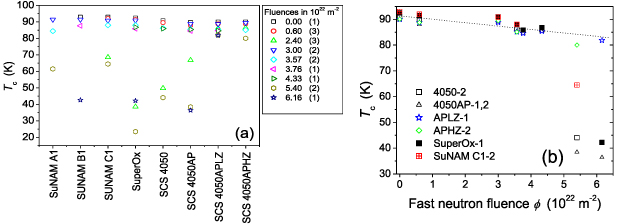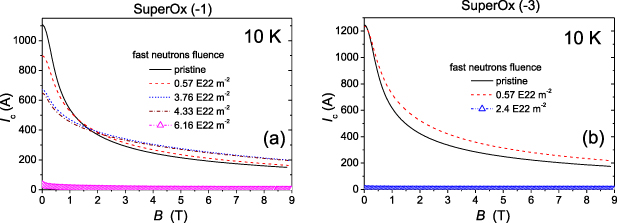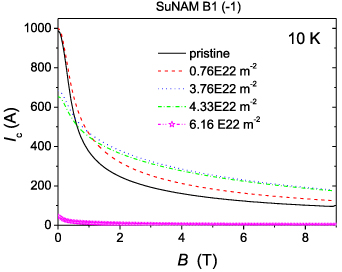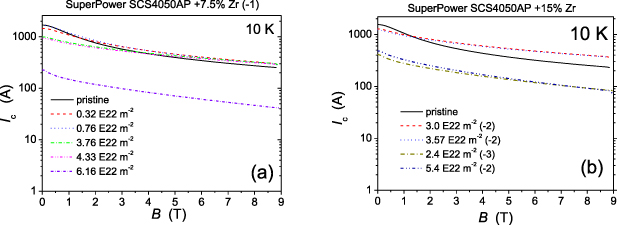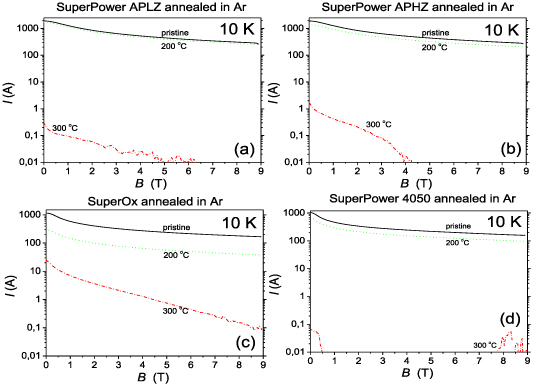Abstract
The impact of neutron irradiation on the properties of second-generation REBaCuO tapes was studied. The main aim of the present study was to identify the fast neutrons irradiation fluence threshold, φth, at which the high-field critical current at low temperatures, Ic (10 K, 8 T), starts degrading. Following up on our previous publication for low irradiation fluences, two new irradiation steps were added. Up to the last but one irradiation step, the Tc in all samples followed a linear dependence on the fast neutrons irradiation fluence, Tc(φ) ≈ Tc(0) − τφ (τ being a numerical constant in units of K/1022 m−2 and φ in 1022 m−2). In parallel, Ic (10 K, 8 T) continuously grew with φ up to the threshold fluence, φth ≈ 3× to 4.3 × 1022 m−2. The last gradual irradiation by φ≈ 1.83 × 1022 m−2 brought a severe degradation both in Tc and Ic (10 K, 8 T) in most samples, irrespective of their irradiation history. This effect was attributed to radiation overheating. Annealing of pristine tapes in dilute Ar confirmed this scenario. Two of the SuperPower tapes, doped by Zr, appeared to be exceptionally stable against both types of overheating. The tape doped with 7.5% Zr, Tc(φ) followed the linear dependence up to the highest cumulative fluence φ =6.16 × 1022 m−2, while the Ic (10 K, 8 T) drop was several orders of magnitude lower than in the samples without Zr. TEM study found that the Zr-doped tapes survived the overheating during the last irradiation step in a crystalline form, while all other samples were amorphized.
Export citation and abstract BibTeX RIS

Original content from this work may be used under the terms of the Creative Commons Attribution 4.0 licence. Any further distribution of this work must maintain attribution to the author(s) and the title of the work, journal citation and DOI.
1. Introduction
In the presently constructed and designed fusion reactors, like DEMO, ITER, CFETR etc, magnet wiring counts with classical, low-Tc superconductors cooled by liquid helium [1]. This coolant is expensive by itself and due to its high volatility, the magnets require perfect thermal insulation, making them structurally complicated, robust, and again costly. High-Tc superconductors (HTSCs) are an alternative with much higher critical temperature. In fact, the operating temperature cannot be much higher than that of classical superconductors, because the high-field critical currents needed for the fusion reactor magnets in HTSCs are only high enough at temperatures below 30 K [2–7]. In any case, the potential operating temperature is high enough to cool HTSC magnets in cryogen-free refrigerators. Another benefit is the much wider safety margins, both in temperature and magnetic field. One of the problems to be studied before use of superconductors in fusion reactors is their response to neutron irradiation. It is known that neutron irradiation of HTSCs slightly depresses Tc. On the other hand, it creates point-like defects and/or their cascades [8–10], size of which is appropriate to enhance vortex pinning at high magnetic fields and thus high-field critical currents, especially at low temperatures. With increasing neutron irradiation, the defect structure densifies, and the high-field critical currents grow. Finally, the superconductor's microstructure changes to such an extent that the vortex lattice is not able to further react to the changes in the defect landscape and the high-field critical current starts degrading. This limit depends on temperature, magnetic field, superconductor type, and other circumstances. In our previous work [7], the effect of neutron irradiation on Tc, critical current density, Jc, pinning force density and magnetic relaxation was studied for three steps of gradual neutron irradiation. At this stage, the high-field Jc at low temperatures kept growing with increasing neutron fluence, without reaching a threshold. In the following work, our main goal was to extend the irradiation range up to the neutron fluence threshold. For this purpose, two further gradual neutron irradiations were performed. We focused on the low temperature response, 10 K, and studied the effect of irradiation in terms of fast neutron irradiation fluence (E ⩾ 0.1 MeV), fast neutrons being claimed to be decisive for the formation of effective pinning centers. We note that the small samples cut from the tapes are quite brittle and a significant part of them were damaged and had to be replaced by new ones. Only four samples of the original set (group (1)) survived the quite complicated manipulation and transport. The neutron irradiation study requires many irradiation steps. It is rather expensive and time-consuming even if the irradiation is stepwise, using the same samples several times. The gradual irradiation process makes the samples' transport and manipulation even more demanding. It is also the reason, why some of the data from paper [7] appears here, too, and forms a part of the present database.
2. Experimental details
Altogether, 18 samples with various irradiation histories were irradiated in the last two irradiation steps. Samples of about 2 × 2 mm2, cut from the central parts of tapes by an electrical discharge wire-cut machine, were irradiated in the LVR-15 research fission reactor in the Research Centre Řež near Prague [11]. The samples were irradiated by being plugged separately in a scrunched Al-foil in bores drilled in a massive Al prism holder. This holder was inserted into a glass ampule, which was then evacuated, filled with a dilute argon gas, and sealed. Finally, the ampule was wrapped in Cd foil to shield the samples from thermal neutrons. The neutron fluence was measured using three sets of activation detectors composed of Ti, Fe, Ni, and Co foils, one set being placed inside the glass ampule, the other two outside. The induced activities were measured with the HPGe detector and the fluences were evaluated using the STAYSL code [12]. From the outside, the ampule was cooled by water to 55 °C. The thermal contact of the sample holder with the glass tube is not perfect and thus, due to radiation heating, the temperature of the irradiated samples might be higher than 55 °C. Samples were irradiated stepwise to five fluences as shown in table 1. Each sample was first measured in the pristine form [13] and then after each irradiation step. We stress that 'neutron fluence' in this paper always means fast neutron fluence (E > 0.1 MeV), in contrast to [7], where the neutron fluence mostly refered to the total fluence.
Table 1. Neutron fluences achieved in the individual irradiation steps.
| Neutrons | Energy (MeV) | Fluence (1022 m−2) | ||||
|---|---|---|---|---|---|---|
| Step 1 | Step 2 | Step 3 | Step 4 | Step 5 | ||
| Thermal | 0–0.005 | 0.006 | 0.003 | 0.07 | 0.039 | 0.14 |
| Epithermal | 0.005–0.1 | 1.73 | 0.3 | 5.5 | 0.32 | 2.09 |
| Fast | 0.1–20 | 0.6 | 0.16 | 3 | 0.57 | 1.83 |
| Sum | 0–20.105 | 2.32 | 0.467 | 8.5 | 0.93 | 5.36 |
| Channel | Dona | Dona | Dona | Dona | H6 | |
| Irradiation time (h) | 48.0 | 24.0 | 215.2 | 85.8 | 14.5 | |
Note: The fast neutron fluences as reported in the text are here given in bold.
The samples involved were cut of GdBa2Cu3Oy tapes (SuperOx and SuNAM), (Y,Gd)Ba2Cu3Oy tapes (SuperPower (SCS4050AP type)), and YBa2Cu3Oy tapes (SuperPower (SCS4050 type)). Two SCS4050AP wires were Zr-doped, one with 7.5% Zr (marked further also as APLZ) and the other with 15% Zr (marked also as APHZ). Most data presented in this paper concern tapes prepared on Hastelloy substrates 4 mm wide, the tapes being copper plated. The superconducting layers were 0.8–1.5 µm thick. The SuNAM tapes were prepared in three forms, namely silver-sheathed (A1), bronze-packed (B1), and copper plated (C1).
As mentioned above, the samples are quite fragile. A lot of them were damaged during the complex manipulation and transport. The studied samples finally formed three sets marked 1, 2 and 3, with different cumulative fluences, as shown in table 2. Set 1 consisted of samples SuperOx-1, SuperPower SCS4050AP-1, SCS4050AP + 7.5%Zr-1 (APLZ1), and SuNAM B1-1. Set 2 comprised SuperOx-2, SuperPower SCS4050-2, SCS4050AP-2, SCS4050AP + 7.5%Zr-2 (APLZ2), SCS4050AP + 15%Zr-2 (APHZ2), and SuNAM A1-2 and C1-2. Finally, set 3 included samples SuperOx-3, SuperPower SCS4050-3, SCS4050AP-3, SCS4050AP + 7.5%Zr-3 (APLZ3), SCS4050AP + 15%Zr-3 (APHZ3), and SuNAM C1-3 and C2-3. Only the last tape was fabricated on a non-magnetic stainless-steel substrate. This, however, did not affect its behavior with respect to the other tapes prepared on Hastelloy.
Table 2. Cumulative fast neutron fluences received by three sample sets during five irradiation steps.
| Sample set | Cumulative fast neutrons' fluence (1022 m−2) | ||||
|---|---|---|---|---|---|
| Step 1 | Step 2 | Step 3 | Step 4 | Step 5 | |
| 1 | 0.6 | 0.76 | 3.76 | 4.33 | 6.16 |
| 2 | n.a. | n.a. | 3 | 3.57 | 5.4 |
| 3 | n.a. | n.a. | n.a. | 0.57 | 2.4 |
Critical temperature, Tc, was deduced from the superconducting transition measured by the superconducting quantum interference device (SQUID) magnetometer. After zero-field-cooling (ZFC), a magnetic field of 5 mT was switched on. Then, field-warming up to 100 K was executed, followed by field-cooling (FC) down to about 20 K. Tc was determined as the temperature, where ZFC and FC curves split, as indicated by the circle in figure 1.
Figure 1. Schematic view of Tc determination.
Download figure:
Standard image High-resolution imageElectromagnetic properties were classified in terms of the critical current, Ic, flowing through the tape cross-section, wc. Ic was calculated using the Bean critical state formula extended for a finite rectangular sample [14, 15],

Here, Jc is critical current density, a and b are the sample dimensions transversal to the magnetic field direction, b ⩾ a, w is the tape width, w= 4 mm for all here investigated samples, c is the superconducting layer thickness, and Δm is the magnetic hysteresis loop (MHL) height. When a, b and w are given in mm, c in µm, and Δm in memu (10−6 A m2), then equation (1) gives Jc as 105 A cm−2 and Ic as A. According to equation (1), Ic does not explicitly depend on c. This fact allows us to avoid the problem of a-priori unknown c. The MHLs were measured inductively, by means of a vibrating sample magnetometer, one of the options of Physical Property Measuring System equipped with 9 T magnet (PPMS 9). The MHLs were measured mostly at 10 K.
3. Experimental results
3.1. Critical temperature
Tc data measured on eight representative samples after each irradiation step are displayed in figure 2(a). In the pristine state, the Tc of all the tapes lie in a quite narrow band between 89.47 K and 92.96 K (see table 3, Tc(0)). The numbers in the round brackets in the panel of figure 2(a) mark the set to which the respective sample belonged (according to table 2). With the cumulative neutron fluence increasing to 4.33 × 1022 m−2, the Tc of all samples can be expressed as

Figure 2. (a) Tc evolution in eight representative samples with increasing cumulative fast neutrons fluence, φ. All the data lying below 70 K were measured after the last irradiation step. (b) Tc(φ) dependence of several samples. The dotted line denotes equation (2).
Download figure:
Standard image High-resolution imageTable 3. Parameters of the linear Tc(φ) dependence in six studied tapes.
| Sample | SuperOx | SuNAM C1 | SuperPower SCS4050 | SuperPower SCS4050 AP | SuperPower APLZ | SuperPower APHZ |
|---|---|---|---|---|---|---|
| Tc0 (K) | 92.77 | 92.96 | 90.53 | 89.47 | 90.20 | 89.84 |
| τ (K/1 × 1022 m−2) | −1.37 | −1.11 | −1.13 | −0.96 | −1.26 | −1.25 |
φ being in units of 1022 m−2 and the numerical constant τ in units of K/1022 m−2. The dotted line in figure 2(b) denotes equation (2) for the SuperPower sample doped by 7.5% Zr, APLZ. Due to the highly time-consuming process of neutron irradiation to high fluences, the last irradiation step was executed in another reactor channel (H6) than all preceding ones (channel Dona). The samples were much closer to the neutron source and the irradiation process was about 20 times faster than before. After this irradiation step, a large drop in Tc was observed in most samples, irrespective of their irradiation history (figure 2(a)). This fact made us think about radiation overheating that caused such a superconductivity degradation. This effect was observed in all samples except those doped by Zr (APLZ and APHZ), where Tc(φ) dependence followed equation (2) up to the highest respective cumulative fluences (see figure 2(b)).
3.2. Critical currents
The evolution of Ic(B) dependence with an increasing cumulative neutron irradiation fluence in SuperOx tape is displayed in figures 3(a) and (b). While low-field Ic continuously decreased with increasing cumulative irradiation fluence, giving evidence for a granular character of the superconductor, the middle- and high-field Ic grew with φ, dominating over the Ic(B) curve of the pristine sample, in response to the prevailing effect of point-like defects formed by irradiation. The threshold φ value, where Ic (10 K, 8 T) stopped rising, was for the SuperOx(1) tape φth ≈ 4.33 × 1022 m−2. In accordance with Tc behavior, a dramatic Ic depression appeared after the last irradiation step (the lowest curves in figures 3(a) and (b)). Such an Ic drop was also observed in the SuperOx (3) sample, where the final cumulative φ was only 2.4 × 1022 m−2, significantly lower than φth of the SuperOx (1) sample (figures 3(a) and (b)). Again, it indicated that the superconductor damage was due to a different mechanism than overcoming the irradiation threshold. Figures 4(a) and (b) show the similar behavior of two SuperPower SCS4050AP samples and figure 5 presents the similar data for the SuNAM B1 specimen. One can see that irrespective of the superconductor type and fabrication process, the same scenario governed Ic behavior in all the samples; except the last irradiation step, neutron irradiation had a positive impact on middle- and high-field critical currents up to a threshold fluence, φth, (about 4.3 × 1022 m−2 for SuperOx and SuperPower 4050AP (1), 3 × 1022 m−2 for SuperPower 4050AP (2), 4 × 1022 m−2 for SuNAM B1 (1) wire). Although the φth value somewhat fluctuated from sample to sample, its value fell in all the samples into a quite narrow range 3–4.33 × 1022 m−2. This result agrees with the data published by other authors [6, 16]. Moreover, this fluence range lies above the lifetime neutron fluence predicted for ITER and DEMO fusion reactors.
Figure 3. Ic(B) dependence at 10 K (a) for four cumulative neutron fluences in the sample SuperOx (1), (b) for two cumulative neutron fluences in the sample SuperOx (3).
Download figure:
Standard image High-resolution imageFigure 4. Ic(B) dependence at 10 K of two SuperPower SCS4050AP samples ((Y0.5,Gd0.5)-123), group (1) for four cumulative neutron fluences (a) and group (2) for three cumulative neutron fluences (b). The final Ic degradation seems to be more due to sample overheating than overcoming the neutron fluence threshold.
Download figure:
Standard image High-resolution imageFigure 5. Ic(B) dependence at 10 K of SuNAM B1 (a brass-laminated sample, set 1) for four irradiation fluences.
Download figure:
Standard image High-resolution imageNearly total degradation was observed in 16 samples after the last irradiation step, irrespective of the samples' irradiation history, giving a strong argument for radiation overheating being the main reason of the superconductor damage.
In this regard, the SuperPower samples APLZ and APHZ require special attention. In these samples, in accordance with their Tc(φ) behavior, high-field Ic was much more stable with respect to a high irradiation. The high-field Ic of the APLZ sample grew with increasing φ up to φth ≈ 4.33 × 1022 m−2. After the last irradiation step, the high-field Ic dropped, however, the Ic depression was several orders of magnitude weaker than in samples without Zr. The APHZ sample from set (1) was damaged. Another two samples were cut from the same tape and received the highest cumulative fluences 5.4 × 1022 m−2 (set 2) and 2.4 × 1022 m−2 (set 3). The final Ic degradation was by several orders of magnitude weaker in all three Zr-doped samples (figures 6(a) and (b)) than in samples without Zr. Irradiation threshold of the APHZ sample (figure 6(b)) was found to be around 3 × 1022 m−2.
Figure 6. Ic(B) dependences at 10 K of SuperPower SCS4050AP sample doped (a) by 7.5% Zr (set (1)) and (b) of the samples doped by 15% Zr (sets (2) and (3)).
Download figure:
Standard image High-resolution image3.3. Annealing experiment
During the last irradiation step, the samples were supposed to be overheated by an intense flow of neutrons and gamma rays. We needed to prove it and to find the temperature the samples could achieve during the last irradiation. Recently, the effect of annealing in various ambient atmospheres on coated conductor (CC) tape properties was studied in Vienna [17]. Particularly relevant to our experiments was the annealing of pristine CC tapes in an argon flow at a series of temperatures up to 400 °C, where a gradual degradation of the superconducting characteristics was observed. This is closely related to the neutron irradiation in Rez, since the glass ampules with samples were evacuated and then filled with a diluted argon gas before irradiation. This fact implies that one of the main reasons for the superconductor degradation during the last irradiation step might be the loss of oxygen during a casual intense radiation heating. To verify this consideration and find the temperature to which the samples were heated during the last irradiation, we annealed some pristine samples at 200 °C and 300 °C for 15 h (the time equal to the neutron irradiation duration in the last step) in a dilute Ar atmosphere. Figures 7(a)–(d) show a slightly sample-specific start of degradation at around 200 °C and a progressive degradation caused by annealing at 300 °C. In accordance with the neutron irradiation, the Zr-doped specimens exhibited only a weak annealing effect at 200 °C. Comparing figures 6(a), (b) and 7(a), (b), we deduced the temperature that the samples might receive during the last irradiation to be about 230 °C–250 °C. Figure 7 shows that in contrast to irradiation, heating in argon affects Ic in the whole magnetic field range in the same way. The experiment also indicates that the samples do not like temperatures above 200 °C. This reflects an enhanced mobility of oxygen in the superconducting layer above 160 °C [17]. Therefore, much better sample cooling during irradiation must be assured. As regards the mechanism of the superconductor degradation, sample overheating in Ar atmosphere might be caused by (i) escape of oxygen from the superconducting layer, (ii) mechanical destruction due to a different thermal expansion of the neighboring tape components, and, as shown further, (iii) destruction of the (poly)crystalline structure of the superconductor into amorphous one. While at least a partial recovery of the tapes can be provided by annealing in oxygen [17], the other two destructive mechanisms are irreversible.
Figure 7. Ic(B) dependences at 10 K after tape annealing at 200 °C and 300 °C for 15 h for (a) SuperPower SCS4050AP + 7% Zr (denoted as APLZ), (b) SuperPower SCS4050AP + 15% Zr (APHZ), (c) SuperOx sample and (d) SuperPower SCS4050.
Download figure:
Standard image High-resolution image3.4. Transmission electron microscopy
Clear arguments for the different response of Zr-doped tapes and those without Zr to radiation overheating led to transmission electron microscope (TEM) and energy-dispersive x-ray spectroscopy (EDS) studies. Figure 8 (upper row) shows the bright-field TEM (BFTEM), while the lower row presents the selected area electron dispersion (SAED). Figure 8 (middle and right) indicates that the Zr-doped SuperPower samples APLZ and APHZ survived the last irradiation in the crystalline form, while the BFTEM image (top left) shows voids appearing in sample SCS4050AP after the radiation overheating. Moreover, SAED (figure 8, bottom left) presents a partial amorphization of the original crystalline structure of the SCS4050AP sample. Evidently, the BaZrO3 columnar structure formed in the Zr-doped samples supports stability of the entire superconducting structure and hinders the degradation observed in other tapes.
Figure 8. Bright-field TEM of the SuperPower tapes: SCS4050AP (top-left); APLZ (7.5% Zr, top middle), and APHZ (15% Zr, top right). Bottom: the corresponding SAED images; c-axis was always vertical.
Download figure:
Standard image High-resolution image4. Summary
Eighteen samples cut from nine commercial CC superconducting tapes from three manufacturers were gradually irradiated by neutrons. In combination with three preceding irradiation steps, the effect of fast neutrons on Tc and Ic was investigated. For the first four irradiation steps, Tc linearly drops with increasing φ as Tc(φ) ≅ Tc(0) − τφ, where τ is a numerical constant in units of K/1022 m−2 and φ in 1022 m−2). In two SuperPower specimens doped with 7.5% and 15% Zr, this linear dependence persisted up to the highest cumulative fluences received by these samples, 6.16 and 5.4 × 1022 m−2, respectively. In parallel, the high-field Ic at 10 K, Ic (8 T, 10 K), continuously increased with φ in all specimens up to the threshold φth, where Ic (8 T, 10 K) then begins to decrease. For all samples, φth laid in the range 3.0× to 4.33 × 1022 m−2. The last irradiation step, by 1.83 × 1022 m−2, ought to confirm the threshold position. It really led to a drop in Tc by several tens of K and in Ic (8 T, 10 K) by several orders of magnitude. This was observed in all samples, except the Zr-doped ones, where Tc and Ic(B) degraded considerably less. In any case, the severe degradation of Tc and Ic in samples without Zr appeared irrespective of the irradiation history, even in samples cut from the same tape and having much different cumulative neutron fluences, even less than 2.5 × 1022 m−2. These results exclud neutron irradiation from the possible reasons for the observed superconductivity destruction. The severe degradation of superconductivity was finally attributed to radiation overheating. Annealing experiments with virgin samples in a dilute Ar atmosphere verified this scenario and helped to specify the equivalent overheating temperature during the last irradiation to 230 °C–250 °C. TEM studies showed different microstructure changes in the overheated samples with and without Zr. In all aspects, the Zr-doped samples manifested much higher stability against overheating of any kind. This is certainly a very good message for applications of CC tapes, particularly in fusion reactors. In real devices in the field of neutron irradiation, HTSCs will operate at low temperatures to create high magnetic fields. Furthermore, the neutron irradiation in real reactors is much slower than that in the present experiment. This means that in reality the phenomenon of irradiation overheating would be absent. However, it is still good to be aware of the potential effect of overheating on a superconductor and the responses of different types of superconducting tapes to it.
Acknowledgments
This work has been carried out in the framework of the EUROfusion Consortium and received funding from the Euratom research and training program 2019–2023 under Grant Agreement Nos. 633053 and 101052200. The views and opinions expressed herein do not necessarily reflect those of the European Commission. Neither the European Union nor the European Commission can be held responsible for them. The activity has been also partly financed from the Strategy AV21 of the Czech Academy of Sciences within the research program 'Sustainable Energy'. Magnetic experiments were performed in the Materials Growth and Measurement Laboratory (http://mgml.eu) receiving support from the program of Czech Research Infrastructures No. LM2018096. Irradiation costs were covered by the Ministry of Education, Youth, and Sports of the Czech Republic (MEYS CR) by the projects LM2015074 and LM2018120. CzechNanoLab project LM2023051 funded by MEYS CR is gratefully acknowledged for the financial support of the measurements/sample fabrication at Laboratory of Nanostructures and Nanomaterials (LNSM).
Data availability statement
All data that support the findings of this study are included within the article (and any supplementary files).
Conflict of interest
There is no conflict of interest.
Ethics statement
Our research does not include studies on human or animal subjects, human or animal tissues or data.


